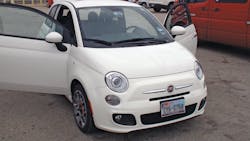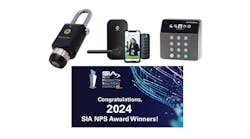After almost 30 years, the Fiat Company is back to selling cars to the U.S. market. At this time, the Fiat Company owns about 70 percent of the Chrysler Corporation. With this much invested in the company, we can expect more and more changes in the Chrysler vehicle line. Some Chrysler vehicles are equipped with Fiat 500 Transponder software, for example the 2011 Chrysler Journey and Charger. More and more of the Chrysler products will be going to this software system. Outside of the U.S., these are some of the more difficult vehicles to service.
Photo 1 shows the Fiat 500 hatchback. The first thing we are going to do is work on the door lock, shown in Photo 2. Warning: there is a lot of plastic on this unit. Proceed with caution as we pull the door panel apart.
Looking over the car, we opened the rear deck and found a storage compartment inside. We opened it up and located a card with Electronic Code and the Mechanical Code (Photo 3). All the locks we worked on had this Mechanical code printed on it. So if you are making keys for this unit, look in the rear compartment for a card. If you find one, you will have a key code and PIN number in hand.
These units take a two track HS Key (Photo 4). It utilizes the VW style worm cut in the key blade (Photo 5). Most high security key cutting machines in the market today will cut this key. It comes with the Standard IKE Remote Key and transponder system seen in most all the cars today.
At the time of this writing, it appears that the Advanced Diagnostic Device can program with a PIN number and the Zedbull can pull the PIN number and program the transponder part of the key. But in order to program the remote portion, a different PIN number is required. This is contained in the ECU of the unit and is said to be encrypted. The dealers have not been very helpful in acquiring the PIN number so you can program the remotes. It varies by area and dealer.
Photo 2 shows the door lock on this vehicle before we begin. The small torque screw on the left does not release the lock or allow you any other access. The door panel on this unit came off the hard way as you will see in the next few steps.
Plastic Door Handle
As we start, identify the two screws on the outside edge of the door -- one screw toward the top and another toward the bottom. The little plastic plug that covers these holes usually break upon removal. This isn't a huge issue. If you are going to be doing any re-keying or repairing and you feel this can be a problem, you may want to buy some replacement covers for these screw holes.
Photo 6 shows where a retainer screw goes into the side of the door. There are no other screws on the outside of this door trim on this model. It may be different with other models. Once these two screws are removed, we can work on the interior door handle and arm rest.
It is important to note that the inner door handle is all plastic. Nothing is holding this on except some very easy-to-break tabs as seen in Photo 7. Note the larger tab can be difficult to pop off. Once you remove this door handle, you will see a Phillips screw to remove. This is set back in the hole fairly deep (See Photo 8). Just unscrew it then set it aside where you will not lose it. It isn't an average type screw like you will find at the hardware store. Remember, you are dealing in metric sizes here.
Next up is the arm rest and the two screws behind the panel. Take a small screw driver and gently pop the cover off. Once it is off, you will see two Torque screws behind it.
Removing Door Panel
At this point you should be ready to remove the door panel. It is held on by the common plastic tabs as you can see here with Stacy pulling the panel Photo 9.
The next step is to release the door handle cable, and in this case, an automatic mirror switch. Both unplug and come off easily. Now you can grab hold of the whole door panel and pull it toward you. It will pop off cleanly. Nine plastic tabs were holding the door panel on.
Now we can address the other issues involved with this car. There seemed to be a lot more plastic than we have seen before. After we removed this panel, we discovered foam covering over the whole door. The only thing we can see outside this foam are the speaker, the door handle cable and remote mirror controls.(See Photo 11).
We carefully proceed to peel this away from the door so we can access the doors inside panel. There is no way you can salvage ANY of this foam. The glue on the side is impossible to remove. We ended up tearing all the foam off.
Next, remove only what’s necessary in order to access the door lock and door handle. It is a very tight process and you need to do this in order as described here.
Inside this door panel are two door handle rods (Photo 12). The most obvious choice would be to remove the first one closest to you. Do not do this. Remove the second and hardest one first. We found that you have to pull the outside door handle in order to remove this black lock rod from the inside. By pulling the door handle, you raise the white rod out of the way to allow you to get the black rod off. When the door handle is static, it is in the way. (See Photo 13.)
Next, remove one nut holding the front part of the door handle.
We are now ready to remove the door handle. This turned out to be a little tricky. It is a very tight fit and we had to move it around quite a bit to get it out of there. Be patient it will come out (Photo 14). At first we thought something else might be holding the handle but there wasn’t. It just took a few minutes of moving it around to work it out. You can see on the label where we scrapped it up a little while working it out of the door Photo 15 .
On the left you can see where the rods attached inside the door panel. You have to pull the handle out to get to the back rod first, and then take the first and closest rod (Photo 16).
We will now get into taking the cylinder out of the handle. This turned out to also be a little complicated. First, remove the three Torque headed screws holding this portion of the handle together, shown in Photo 17.
There are several steps in the procedure. First, we used a long Torx wrench to get down into the screw, shown in Photo 18. Next we had to take the lock rod apart on the right side to get to the screw underneath there (Photo 19).If you could pull the door handle and still get to this screw, that will also work. This just seemed to be an easier way.
The left side of Photo 20 shows the screw we needed to remove. Take the lock rod out and then pull the plastic holder out. Once you take the rod off and remove the plastic, you will have access to the screw beneath, shown in Photo 21. Once the obstructions were removed, we can access the third and last screw.
The next step is to remove the outer housing of the door handle. You must depress a tab to pull this apart , shown in Photo 22. In order to depress the tab, remove the outer door handle from the lock cylinder assembly (see Photo 23). There are two pieces to this assembly when you remove it, but you only have to remove the outermost covering. As long as you can remove the cylinder once the back portion is off, you don’t need to remove anything else on the front side of the door handle. Once the three screws are removed, pull this part of the cylinder apart. This is one of several parts as you will see.
Disassembling the Cylinder
We will now draw our attention to the back side of the cylinder since this all has to be taken apart to get the cylinder out. The first part is the plastic lock rod holder. The key phrase here is “plastic.” You will have to proceed slowly so as to not break any of these parts.
Three prongs must be slowly worked off and over the end of the back cylinder. Carefully and slowly work each prong loose one at a time (See Photo 24). As shown in Photo 25 with all the prongs loose, the end slides off.
Now we need to remove a spring (Photo 26). The spring just comes out but the clip has to be pushed to grab a side of it to pull off.
The clip holding the cylinder can be pulled up with a small screwdriver and then pulled off (Photo 27.) This should now allow the cylinder to slide out of the housing (Photo 28).
The Key Code and we believe the part numbers are stamped on the cylinder, shown in Photo 29. In Photo 30, you can see the cylinder with the key up to it and they both have the C265 number on them. Photo 31 shows the cylinder with key removed, and you can see the wafers popping up.
Wafer Removal Challenges
Now you might say, “Okay. We can repair or replace the wafers.” Not so fast. We could not get the wafers out without destroying them. This is the first time we have seen this car and we still are not sure what is holding the wafers in the cylinder, but we had to force the wafer out of the door cylinder. This bent and pushed the soft metal tumbler to where it is no longer usable (Photo 32). There was a very small nipple on the reverse side of the wafer holding them into the cylinder. We tried several different approaches and nothing worked, short of forcing the tumbler out. That ruins it for reuse.
We can only suggest that you have a pin kit for this vehicle and hope you can put them back in without damaging them. As you will see later, all the wafers in the ignition come out easily.
At this point we have completed the door lock removal and disassembly. Part 2 of this article will address servicing the ignition lock, key cutting and transponder programming. Any questions can be sent to the authors at e-mail addresses [email protected] or [email protected].
Editor’s Note: Check out tseveral helpful videos from author Jim Hetchler. Just click on the video links in the Related Content box accompanying the article.






